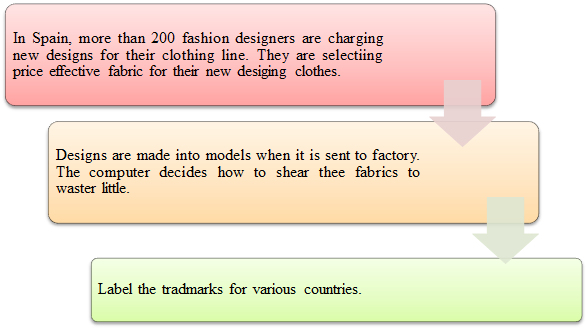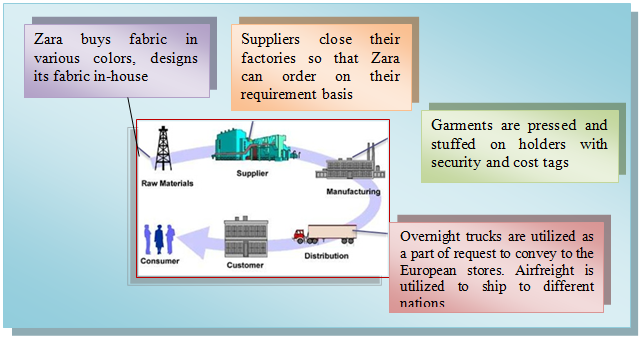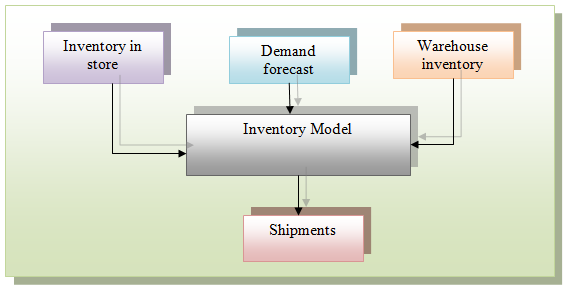Supply Chain Management of Zara Fashion Industry
Discuss about the Logistics Management in Zara for Product Distribution Management.
Zara is one of the leading fashion companies, which is functioning in Spain. The company is founded in the year 1975. It belongs to Inditex, which is one of the biggest distribution groups. The products of Zara are men and women clothes. It also sells shoes, accessories as well as cosmetics. It also sells children’s clothes. Zara expanded its domain from Spain to rest of the world and in Portugal. By the year 1990, the store expands into United States, France as well as Europe. The success of Zara is large to their way as it keeps with street fashion with changing times. Zara is well known for their eco-friendly companies (Zara.com, 2015). It is well known as one of clothing brands, which produces 100% of toxic-free clothing.
The report is based on supply chain management of Zara fashion industry with logistics supply chain of the fashion industry, its sustainability as well as reverse logistics used by Zara. The fashion industry makes their business sustainable if the retailers, as well as designers, are sustainable in their sustainability norms. The report also reflects on proposed model of Zara’s supply chain so that there is an improvement in their sustainable supply chain management.
Logistics supply chain of Zara
Over the last decades, Zara had introduced just-in-time supply chain in their fast fashion industry. It becomes third in the retail ranking. The key success of Zara fashion industry is vertically integrated supply chain where the production, design as well as distribution are integrated (Christopher, 2016). Their production system permits to place the garment in any store around the globe in the stage between two-three weeks. The factories of Zara can raise as well as decline their production rapidly and therefore there are fewer inventories in their supply chain. The organization buys huge quantities of four kinds of fabric and does their design of garments as well as related cutting as well as dyeing in-house (Turker and Altuntas, 2014). In this way, the manufacturers of fabric make rapid deliveries of bulk quantities of fabric straightforwardly to their Zara business. The company obtains most of the raw fabric from their suppliers. The suppliers deliver the raw materials within five days of orders placed. Inbound logistics from the suppliers are done through truck (Kim, 2013).

Figure 1: Vertically integrated supply chain management of Zara
Logistics supply chain of Zara
(Source: Kim, 2013, pp-231)
The stores are taking deliveries twice every week. They are requesting stock inside two days of position of requests (Fernie, 2014). The items are dispatched as well as arrived at the store on hangers as well as with tags and costs on it. The items fall off delivery trucks, and then it goes straight to the sales floor. The store administrators can arrange and additionally get the items that the clients need when they require those (Li, et al. 2014). In the late days, Zara utilizes store network to change the way it works in a conventional industry. None of the competitors of Zara can duplicate their plan of action until it duplicates the production network. Zara has put in 30 years constructing their remarkable production network; then the contenders are no more to go before they can make up for lost time.

Figure 2: Zara’s Supply Chain Management
(Source: Li, et al. 2014, pp-827)
Just-in-time (JIT) production
Zara keeps a considerable amount of production in-house as well as makes sure that their factories keep 85 percent of capacity for in-season adjustments (Choi and Cheng, 2015). The in-house production permits the organization to become flexible in quantity, frequency as well as varieties of new products to be launched. Zara achieves fast turnover by producing a smaller product in small quantities (Perry and Towers, 2013). New designs arrive in store in 15 days. Therefore, it is seen that Zara can respond to their customer's demands quickly by producing high quality products. In the business operations of Zara, just-in-time inventory procurement is high forecasting system (Shambu, 2015). The store managers can collect the sales data as well as current trends on a daily basis.
The company is also operating in responsive logistics operation such as each of its 2000 stores receives new items eight times per month. The garments are picked, then packed and finally it is ready for shipping to its distribution centers (Stadtler, 2015). It takes approximately eight hours from the placing of an order by the store manager. In the current market of Zara, delivering high quality of fashionable clothes and low cost product in order to capture are the main concern for the organization to increase their market share (Monczka, et al. 2015). This model helps to reduce the cost of the company as it saves the inventory cost and maintenance of inventory. Finally, JIT also uses to keep the supply on time when there is high demand for company's products.
Just-in-time (JIT) production
Within the fashion industry such as Zara, the demand variation are fast due to new fashion movements as well as unpredictable market situation. The demands are predictable as well as cloud varies and changes in short time, creates high difficulties for the supply chain (Seuring, 2013). Establishment of a lean supply chain in the company enhances its better performance as well as gains a competitive advantage. Zara has well sustained lean business model to stay ahead of their rivals and achieve global success.
Lean production model
Tseng and Hung (2014) stated that the lean production model helps Zara to value their end consumers. There are some of the issues, which are required to overcome in order to take sustainable clothing in the business operations of Zara. Firstly, consumption into the fashion raises a total number of fashionable products that the customers purchase and then dispose of it (Shen, 2014). Secondly, production of cotton requires lost of energy, pesticides, toxic chemicals and water. Those toxic chemicals cause health issues of staffs and environmental issues (Rushton, Croucher and Baker, 2014). Thirdly, unsustainable fibers are taking the time to degrade within the landfill sites. Fourthly, there is consumption of energy when the clothes are washed, and the carbon is burned from the fabrics and clothes (Sarkar, et al. 2016). Therefore, in order cope up with those issues, Zara adapts technology such as lean production system to reduce the waste and gives sustainable products to the customers.
Reduction in solid wastes gives benefits in reducing the cycle time for manufacturing, improvement in product quality, space savings and reduction of inventory, quick response to consumers and reduction in labor expenditures (Wisner, et al. 2014). With the use of efficient fashion supply chain, the organization can eliminate the time waste; then their overall manufacturing cycle time is reduced. The following are the seven rules of the fashion supply chain, which helps Zara to adopt better supply chain management by delivering quality products to the customers (Dyckhoff, Lackes and Reese, 2013). It also reduces the inventory cost with a reduction in lead-time of consumers. The seven rules are discussed as follows:
Production of product in smaller quantity: For the lean manufacturing, a smaller quantity of products is a unique characteristic. Customers require taking quick decisions otherwise the next day, the products they require will go (Bartezzaghi, et al. 2016). The customers are visiting the stores of Zara in order to distinguish new products and make a huge amount of travel as well as revenue.
Sustainability in Zara fashion industry
Centralization design and product develop: Zara develops new products by in-house staffs as well as throughout merchandise (Nagurney and Yu, 2012). The suppliers require sending samples to the buyers. Removal of the back-and-forth communication reduces the market time.
Utilization of work cell business organization: Each of the product development team of Zara has own designers, procurement, manufacture planners as well as sales. It helps Zara in order to streamline their internal communication (Caniato, et al. 2012).
4.Controlling of scheduling: At Zara fashion industry, the store managers can position order two times within a week. The ordered products are ready for shipments, and it is delivered in 24 hours (Tseng and Hung, 2014). Then, the products are displayed at the store in the similar day it has arrived. As it runs at a steady pace, therefore it reduces the waiting time at each step.
Keep the production in-house: Zara attempts to stay away from the low cost country sourcing and then create investments in in-house manufacturing as probable (Shen, 2014). The fashion industry believes that the in-house production assists the organization in order to increase the entire flexibility of their business.
Automation of production and warehouse facilities: Zara considers that in the time-phased rivalry, computerization is the key in order to help their business by increasing the speed as well as the accurateness of business operations.
Adhere to all the rules: Implementation of any one rule within the business operations of Zara is not effective to gain productivity as well as a competitive advantage (Nagurney and Yu, 2012). Then, the fashion industry should adhere to all the rules such that their supply chain should run efficiently as well as effectively.
Zara develops reserve logistics for their business in order to become more sustainable. Zara has considered a more sustainable aspect of their business operations (Wisner, et al. 2014). The organization makes some improvement in their supply chain but lastly they go for reverse logistics of their clothes.
Zara could buy their old clothes for a small price to their customers so that their materials should be reused. It develops a green brand image for the organization by maximizing the capture of value and reuse of raw materials.
The fashion industry should create a closed loop by bringing their products back from the point of consumption to an origin (Seuring, 2013).
Zara should use 5 percent biodiesel fuel for transportation per years that allows the company to reduce emissions of carbon dioxide by 500 tons (Shambu, 2015).
Lean production model
The model is used to minimize the cost to determine the purchasing as well as repairing of lot sizes. It predicts the sales in the store throughout the replenishment period as the purpose of demand forecasts. The execution of inventory model by Zara is to carry their distribution inventory process (Perry and Towers, 2013). This model helps in increasing the sales by 3-4 percent. It reduces the shipment time, boosts the proportion of time that the products of Zara spend on exhibit in their lifecycle. Eight percent of the materials of Zara are manufactured in Europe while 50 percent are made in Zara’s headquarter, Spain (Zara.com, 2015). The local strategic businesses, which the organization upholds with their manufacturers in Europe permit for the product throughout a time of three-four weeks from commencement to distribution. After the adoption of inventory model by the management team, the organization designs as well as cuts their fabric in-house (Caniato, et al. 2012). It acquires different colors of fabrics in order to keep their cost low. The company also postpones dying as well as printing designs of clothes so that they can reduce waste as well as minimize their requirement to clear unsold inventories.

Figure 3: Inventory Model for Zara fashion industry
(Source: Perry and Towers, 2013, pp-481)
Conclusion
It is concluded that the supply chain of Zara provides a deeper understanding of their internal value chain. It also helps to give customer-centric services, customization in technology, vertical integration, leading to speed as well as logistics are their key success factors. The supply chain input, collaboration, information as well as knowledge management raise significant cause of the success of the company. With an implementation of just-in-time supply chain model, it helps Zara to make small batch production and product improvement. Zara gains a competitive advantage in the sense of low prices as well as rapid cycle times, by introducing new fashions. The supply chain management of Zara is a planned differentiator, which guides to a competitive edge. A lean operation is not just a concern for controlling of cost.
It is identified that Zara views its lean operations as well as supply chain as a key approach of business models. The supply chain of the Zara is a good strategic alignment as business processes as well as practices support time-based strategy perfectly. Within Zara, disposable fashion becomes a trend for the fast fashion concept. By implementing the lean manufacturing technique in business operations of Zara, the company can obtain sustainable products and there is a reduction of carbon footprint. The seven rules of fashion supply chain are also responsive within the market.
Seven rules of the fashion supply chain
References
Bartezzaghi, E., Cagliano, R., Caniato, F. and Ronchi, S., 2016. A Journey through Manufacturing and Supply Chain Strategy Research.
Caniato, F., Caridi, M., Crippa, L. and Moretto, A., 2012. Environmental sustainability in fashion supply chains: An exploratory case based research.International journal of production economics, 135(2), pp.659-670.
Choi, T.M. and Cheng, T.E., 2015. Sustainable Fashion Supply Chain Management. Springer: New York, NY, USA.
Christopher, M., 2016. Logistics & supply chain management. Pearson Higher Ed.
Dyckhoff, H., Lackes, R. and Reese, J. eds., 2013. Supply chain management and reverse logistics. Springer Science & Business Media.
Fernie, J., 2014. 02 Relationships in the supply chain. Logistics and retail management: Emerging issues and new challenges in the retail supply chain, p.35.
Kim, B., 2013. Competitive priorities and supply chain strategy in the fashion industry. Qualitative Market Research: An International Journal, 16(2), pp.214-242.
Li, Y., Zhao, X., Shi, D. and Li, X., 2014. Governance of sustainable supply chains in the fast fashion industry. European Management Journal, 32(5), pp.823-836.
Monczka, R.M., Handfield, R.B., Giunipero, L.C. and Patterson, J.L., 2015.Purchasing and supply chain management. Cengage Learning.
Nagurney, A. and Yu, M., 2012. Sustainable fashion supply chain management under oligopolistic competition and brand differentiation.International Journal of Production Economics, 135(2), pp.532-540.
Perry, P. and Towers, N., 2013. Conceptual framework development: CSR implementation in fashion supply chains. International Journal of Physical Distribution & Logistics Management, 43(5-6), pp.478-501.
Rushton, A., Croucher, P. and Baker, P., 2014. The handbook of logistics and distribution management: Understanding the supply chain. Kogan Page Publishers.
Sarkar, B., Sett, B.K., Roy, G. and Goswami, A., 2016. Flexible setup cost and deterioration of products in a supply chain model. International Journal of Applied and Computational Mathematics, 2(1), pp.25-40.
Seuring, S., 2013. A review of modeling approaches for sustainable supply chain management. Decision support systems, 54(4), pp.1513-1520.
Shambu, G., 2015. Using The Fast Fashion Supply Chain To Teach Sustainability. Business Education Innovation Journal, 7(1).
Shen, B., 2014. Sustainable fashion supply chain: Lessons from H&M.Sustainability, 6(9), pp.6236-6249.
Stadtler, H., 2015. Supply chain management: An overview. In Supply chain management and advanced planning (pp. 3-28). Springer Berlin Heidelberg.
Tseng, S.C. and Hung, S.W., 2014. A strategic decision-making model considering the social costs of carbon dioxide emissions for sustainable supply chain management. Journal of environmental management, 133, pp.315-322.
Turker, D. and Altuntas, C., 2014. Sustainable supply chain management in the fast fashion industry: An analysis of corporate reports. European Management Journal, 32(5), pp.837-849.
Wisner, J.D., Tan, K.C. and Leong, G.K., 2014. Principles of supply chain management: a balanced approach. Cengage Learning.
Zara.com, 2015. Company-+ Info | ZARA India. [online] Zara.com. Available at: https://www.zara.com/in/en/info/company-c11112.html [Accessed 4 Sep. 2016].
To export a reference to this article please select a referencing stye below:
My Assignment Help. (2017). Zara Reverse Logistics Management On Product Distribution Management. Retrieved from https://myassignmenthelp.com/free-samples/logistics-management-in-zara-product-distribution-management.
"Zara Reverse Logistics Management On Product Distribution Management." My Assignment Help, 2017, https://myassignmenthelp.com/free-samples/logistics-management-in-zara-product-distribution-management.
My Assignment Help (2017) Zara Reverse Logistics Management On Product Distribution Management [Online]. Available from: https://myassignmenthelp.com/free-samples/logistics-management-in-zara-product-distribution-management
[Accessed 01 January 2026].
My Assignment Help. 'Zara Reverse Logistics Management On Product Distribution Management' (My Assignment Help, 2017) <https://myassignmenthelp.com/free-samples/logistics-management-in-zara-product-distribution-management> accessed 01 January 2026.
My Assignment Help. Zara Reverse Logistics Management On Product Distribution Management [Internet]. My Assignment Help. 2017 [cited 01 January 2026]. Available from: https://myassignmenthelp.com/free-samples/logistics-management-in-zara-product-distribution-management.
